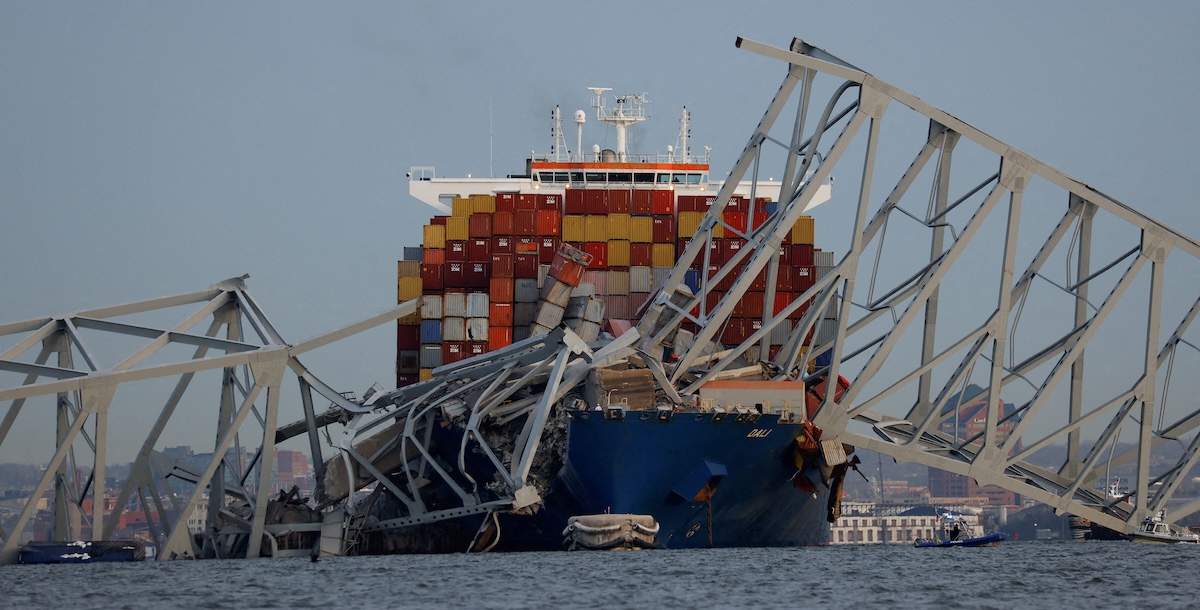Loading player
The collapse of the Francis Scott Key bridge in Baltimore, which occurred during the American night between Monday and Tuesday after the container ship Dali hit one of its pylons, could have important and long-term economic consequences. The consequences of the collapse will certainly affect Baltimore itself, a city of 600 thousand inhabitants in the state of Maryland, but they could also involve the entire trading system in the United States.
First of all, the bridge was used by 35 thousand people a day to cross the Patapsco river: now it will be necessary to find immediate solutions both for the city’s roads and for the land freight transport system. The US authorities have also announced the complete closure of the entire port for an indefinite period of time, because it will be necessary to remove the remains of the bridge and demolish the parts that have not collapsed.
The closure of the port is the event that could cause the most extensive economic damage, although at the moment it is very difficult to quantify their extent. The port of Baltimore, although large and busy, is not one of the largest in the United States: it is the eighteenth in the country in terms of quantity of goods transported, and is several orders of magnitude smaller than the main American ports, such as those of Houston and New York.
Even though it is not very large, it is nevertheless a specialized port, which dealt with the transport of some very specific types of goods. These include cars and work vehicles such as tractors, coal, sugar and liquefied natural gas (LNG).
For each of these goods it is difficult to estimate what the damage will be yet, but in some cases it is possible make hypotheses. One of the sectors most affected will be that of coal, because the port of Baltimore was actually important in this field: it transported 27 percent of all the coal exported from the United States by sea, which was sent mainly to India, China and some other countries. Europeans. This could create problems for the global coal market, also because it is difficult to move shipments from one port to another: coal is moved by rail and rerouting trains to another port could be complicated.
The port of Baltimore was also specialized in the transport of vehicles: last year a total of 750,000 vehicles passed through, including cars and work vehicles such as tractors. It was also involved in the transportation of LNG and sugar, thanks to the fact that one of the main sugar refining plants in the United States is located in the city: however, it is currently unclear what the short-term consequences will be.
More generally, since the global trade system is extremely fragile, as seen in the crises of recent years, even the closure of a port not as large as that of Baltimore can cause problems. If one port closes, other nearby ports will have to accommodate more ships to compensate. But also a 10-20 percent increase in transport volumes can generate enormous difficulties even in the largest ports.
Pete Buttigieg, the US Transportation Secretary, said that “there is no doubt that there will be a large and prolonged impact on supply chains”.
Then there is the damage to the local economy: the port of Baltimore directly employed 15 thousand people, and it is estimated that the related industries contributed at least in part to the livelihood of another 140 thousand people.
As mentioned, the bridge itself was of great importance for the traffic and economy of Baltimore. The bridge connected two parts of the city quite far from the centre, and served above all to relieve city traffic. But it was also the main passageway for road freight transport: according to the American Truckers Association, the annual value of goods that passed over the bridge was 28 billion dollars.
The collapse will mean, for example, that cars will be forced to pass through the city center to get from one part of Baltimore to another, while heavy vehicles or those with dangerous transport, which cannot pass through the center, will have to make long journeys. deviations.
